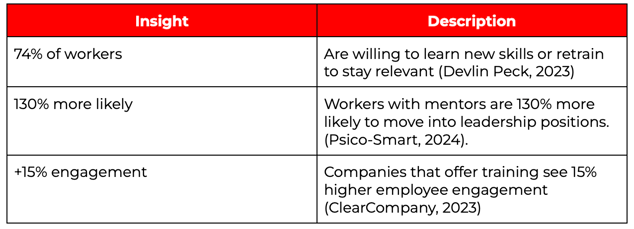From the Factory Floor to the Boardroom: How Education Transforms Careers
On this National Education Day, we’re highlighting how training, mentorship, and continuous learning can reshape the future of today’s workers 📈
INSIGHT
5/2/20252 min read


Today’s workplace is changing fast. Technology, automation, and new ways of working mean that learning can no longer stop after school. For both blue-collar and white-collar workers, education—whether through training, mentorship, or formal courses–has become an important key to career growth.
This article highlights real examples and up-to-date data that show how continuous learning helps workers improve their skills, take on new roles, and reach leadership positions.
Real Stories: Education Changes Lives
Elizabeth Kaehr – Learning Changes Lives
Elizabeth started her career in a manufacturing job. Over time, she joined a mentorship program that allowed her to learn leadership skills and understand her potential. With support and guidance, she moved into a managerial role—something she never imagined before. This story shows that with the right guidance and learning environment, big changes are possible even for those starting in entry-level jobs. (Source)
Workforce Opportunity Services – Helping Workers Grow
Founded by Arthur M. Langer, Workforce Opportunity Services (WOS) has helped thousands of workers—especially those from underserved backgrounds—gain new skills and enter professional industries like IT and finance. WOS combines practical training and soft skills development (like communication and teamwork), showing that education is more than just a degree. (Source)
Why It Matters Today
In the past, many jobs required only basic education and hands-on training. But today, many workers face pressure to adapt to new systems, technologies, and expectations. That’s why more people are seeking out education while they work.
Here are some key insights:
How Workers Can Get Started
You don’t need to go back to university to start learning. Here are practical steps workers can take:
Online Courses — Platforms like Coursera, Skill Academy, and LinkedIn. Learning offers courses in business, IT, communication, and more.
Mentorship Program — Ask your manager or HR if mentorship is available in your company.
Company Training — Many companies offer free or subsidized workshops and certifications.
Peer Learning — Join professional communities or WhatsApp groups focused on skills you want to improve.
Conclusion
Education is not just for students, it’s a lifelong journey for everyone, especially in today’s fast-moving world. Whether you’re on the factory floor, behind a desk, or managing a team, there’s always something new to learn.
As we celebrate National Education Day, let’s remember that learning can open doors, build confidence, and lead to bigger opportunities—no matter where you start.
References:
Devlin Peck. 2023. Employee Training Statistics. Accessed April 29, 2025. https://www.devlinpeck.com/content/employee-training-statistics.
ClearCompany. 2023. 27 Surprising Employee Development Statistics You Don’t Know. Accessed April 29, 2025. https://blog.clearcompany.com/27-surprising-employee-development-statistics-you-dont-know.
Psico-Smart. 2024. The Role of Mentorship in Career Development. Accessed April 29, 2025. https://psico-smart.com/en/blogs/blog-the-role-of-mentorship-in-career-development-11389.
Mentoring.org. 2022. How Mentoring Helped a Young Woman Form Her Career Path. Accessed April 29, 2025. https://www.mentoring.org/blog/in-real-life/how-mentoring-helped-a-young-woman-form-her-career-path/.
Wikipedia. 2024. Arthur M. Langer. Accessed April 29, 2025. https://en.wikipedia.org/wiki/Arthur_M._Langer.
Wikimedia Commons. 2018. Line chart showing labor statistics. Accessed April 29, 2025. https://upload.wikimedia.org/wikipedia/commons/6/65/Line_chart_showing_labor_statistics.svg.


P2SDM Tunaskarya Indoswasta
CONTACT US
© 2025. All rights reserved.




Komplek Ruko Taman Niaga Blok D No. 2 – 3, Sukajadi, Batam.
📞
📧
🏢
